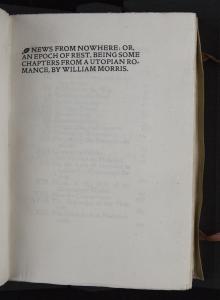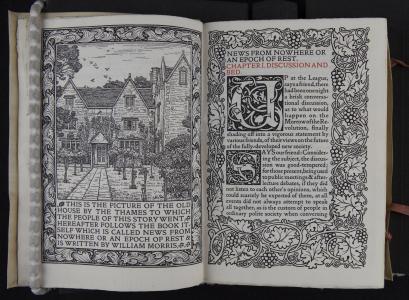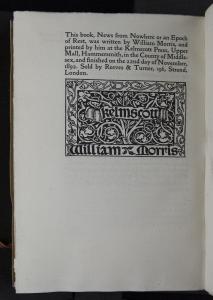

News from nowhere : or, An epoch of rest, being some chapters from a Utopian romance
1. The complaint, and the consolation; or, Night thoughts
2. The Fables of Æesop, and others / With designs on wood, by Thomas Bewick
5. News from nowhere: or, An epoch of rest, being some chapters from Utopian romance
6. The nature of Gothic, a chapter of the stones of Venice
7. Daphnis and Chloe: a most sweet abd pleasant pastoral romance for young ladies
8. The Sphinx
10. Credo
14. Bible.Old Testament. Song of Solomon.
16. Kem byt’? / V. Mai︠a︡kovskiĭ ; ris. N. Shifrin.
17. The ghost in the underblows
19. Bateau ivre
UCLA Call Number:Press Coll. Kelmscott Annex

News from nowhere: or, An epoch of rest, being some chapters from a Utopian romance
Title Page of News from Nowhere

News from nowhere: or, An epoch of rest, being some chapters from a Utopian romance

News from nowhere: or, An epoch of rest, being some chapters from a Utopian romance
The colophon from News from Nowhere printed by William Morris's Kelmscott Press in 1893.
Contributor:
Creator: Morris, William
Publisher: Hammersmith
Publication place: London
Date of Publication:1892
Dimensions: 21 cm x 15 cm x 3 cm
Physical Description:
The book is firm and substantial to the touch. Once out of its protective box the vellum binding is smooth to the touch while it is just barely curving and uneven from the stiffness of the vellum. The fore edges of the vellum binding are scored and folded an eighth of an inch along the fore-edge of the book to just barely cover a part of the page length of the book. The spine of the book has “News from Nowhere by William Morris” stamped in bright gold in Golden type in capital letters. The binding has four rust orange colored silk ties that are each an inch from the top and bottom on both the front and back book covers: they are leaved into the binding itself. These ties might be used to tie the volume closed in the tradition of a book clasp. Once open, the book creaks with the movement and reveals fine, thick handmade paper pages. There is a book label on the lower outside corner of the front cover that specifies that this volume belonged to William Andrews Clark, Jr. There are three blank endpapers that lead to the title page of the book, which is very plain. There is a double-sided table of contents, each side of which faces a blank page.
A frontispiece created from a wood engraving designed by C.M. Gere of Kelmscott Manor is on the verso. The text of the book itself begins on the recto and is printed with both black and red inks. The text itself is bold and dark. This is accentuated by the large white margins that surround the text and give it prominence. Throughout the book, large wood cut initials to begin chapters and paragraphs are used. There are margin notes in the upper corners of each page and small passages emphasized throughout the book using red ink. The colophon at the end includes the printer's mark, which depicts an ornate designed border containing the name “William Morris” on the bottom with a tree inside which includes the “Kelmscott” press name.
Provenance:
According to the inventory of the Clark Library done in 1936 by the cataloger at the time, Frank Lundy,News from Nowhere was purchased for $70.00. This was likely done by Mr. Clark for his library but there is no direct receipt to confirm this purchase. [Footnote 1]
1. Lundy, Frank A. William Andrews Clark Memorial Library: Inventory. December 21, 1936. Private holding of the Clark Library.
Condition
The book is in very good condition. It is housed within a lightweight board box in and is stored in a controlled environment. The vellum binding is still very stiff and has retained its off–white complexion without very much evidence of handling. One of the four orange silk ties has come off and is stored in the box with the book. William Andrews Clark’s personalized book label is on the outside lower corner of the flyleaf. Once the book is open, there is a dark brown stain from William Andrews Clark’s personalized book label on the lower outside corner of the first endpaper. The pages are all in excellent condition with no tears, stains or foxing.
Additional Info:
The book was printed with an Albion press. 300 paper copies were printed. 10 vellum copies were printed. This volume was issued by the press on March 24, 1893.
Interpretation:
One of 53 titles from William Morris’s Kelmscott Press, this edition of News from Nowhere is notable for the frontispiece of Kelmscott Manor in the front of the book. The image is identifiable as being an embodiment of the press and Morris’s work, both literary and artistic. The text of the book itself is noteworthy in that it is the fictionalized description of Morris’s socialist utopian ideals.News from Nowhere is the incorporation of Morris’s utopian dream, based on a world where the occupants work for pleasure as skilled craftsman, and his personal expedition into that sphere.
Throughout the work, Morris extolls the idea that all work should be creative and pleasurable which, in and of itself, is its own incentive. The work itself was originally published in serial form in the socialist newspaper, Commonweal, and was likely meant to serve as much as a political statement as it was about Morris’s ideology. Under the guise of fiction, Morris was able to make pronouncements about multiple topics including: communism, anarchy, capitalism, society, socialism, and his utopian ideals using allegory.
Morris imagined a future utopian society where creative fulfillment, personal freedom, beauty are readily available and are the standard of living. For Morris, socialism may have meant the freedom to pursue individual pleasure and from his perspective that seems to have meant the pursuit and creation of beauty.
Morris lays out an interesting set of blueprints for his idealized society with great care to the tenets of beauty, freedom, and passion for work in this utopian fantasy utilizing his brand of Medievalist romanticism. His utopia appears as an idealized Medievalist civilization where the people are simple and live in spread out rural spaces, technology is not present, and people live their days working and appreciating the fruits of their labors. The entire allegory is based on a theory of aesthetics which encapsulates Morris and his socialist ideals while he blithely ignores economy and infrastructure. This particular printing of News from Nowhere by the Kelmscott Press is all the more interesting in this context as the physical manifestation of Morris’s design aesthetic, gratification from work and his Medieval utopian ideals.
Text Content Description:
The book is a fictionalized description of William Morris’s vision of a society based on his utopian socialist ideals. The narrator of the adventure falls asleep, after a dispiriting socialist meeting in 1890s London, and awakens to find himself in the future where the people he meets speak of 2001 as the past. As the story progresses, and the narrator goes on to have several extended conversational encounters with various inhabitants of this decentralized and agrarian future, the society reveals itself to be a type of socialist utopia where the notions of money and private property do not exist, each citizen is considered equal, and labor is a pleasure shared by each of these citizens. It is revealed that a revolution had taken place and subsequently the people had created the pastoral and idyllic space the narrator tours. There is no urbanized industrial complex but a sprawling and extended community of small towns filled with artisans whose lives are based on the joys of craftsmanship in a “post–industrial” pastoral wonderland that is actually a future-England.
Contributor: Stella Castillo